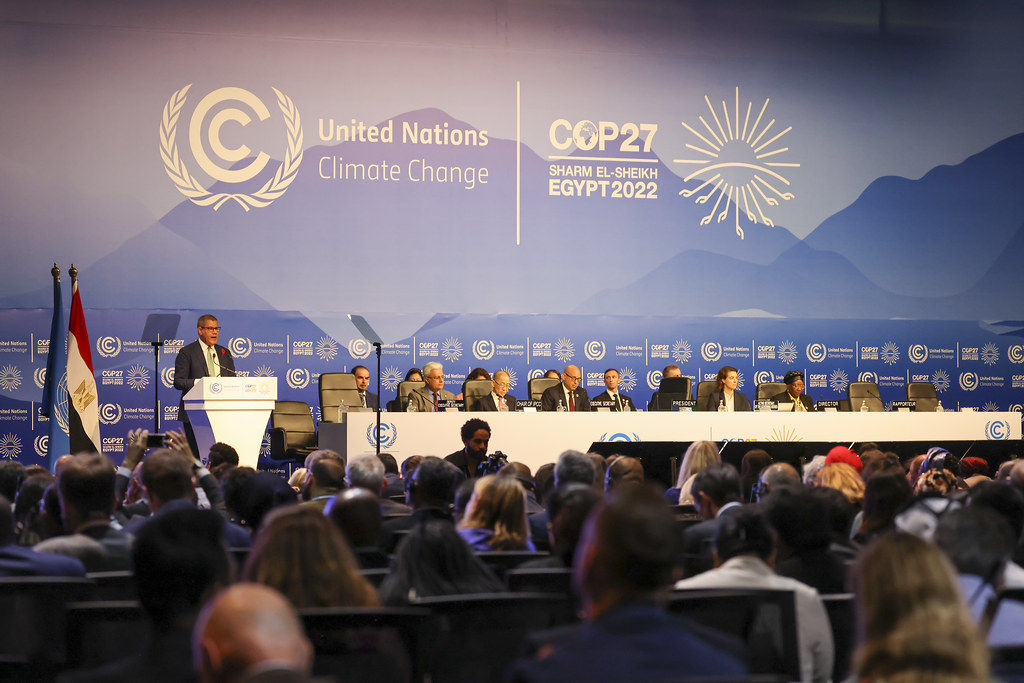COP27 discusses loss and damages in face of climate change
7 NOVEMBER 2022 – Expected to gather representatives from 196 countries, some 45,000 people and 120 world leaders, the 27th Conference of the Parties (COP27) of the United Nations Framework Convention on Climate Change (UNFCCC) opened this Sunday, November 6 2022 in the city of Sharm el-Sheikh, Egypt—and this year’s convention has been dubbed the “Adaptation COP”.

Opening Ceremony of COP 27 in Sharm el-Sheikh, Egypt. Photo by UK Government/Rory Arnold/No 10 Downing Street on Flickr
Against geopolitical crises such as Russia’s invasion of Ukraine, energy shortages in Europe and supply chain disruptions, countries around the world are struggling to keep on track with their climate commitments. Many countries’ plans to transition away from fossil fuels and towards renewable energy have been set back.
An update on commitments
COP26’s pact in Glasgow last year proposed that developed countries—those who have industrialised earlier and played a major part in climate change—provide climate financing between 2025 and 2030 at an amount no less than USD1.3 trillion annually.
However, the opening of COP27 saw the developed nations pushing back on this amount of money. They admitted failure in mobilising the USD100 billion a year agreed in Paris in 2015, and committed to launch a two-year work programme to work out long-term financing and a new collective finance goal to compensate.
A big question at this year’s COP is if it will be possible to get a consensus on the scale and timeframe of adaptation finance, which entails a discussion on vulnerabilities—the “loss and damages” that arose due to climate challenges and defining the eligibility of countries for accessing the funds.
Community-driven initiatives
Adaptation depends not just on the level of financial resources but also the ability of communities exposed to climate change to adapt. Some communities have better ability to adapt, usually due to the resilience of their ecosystems.
Rewarding a community or locally led protection of the ecosystem is seen as the least costly way of promoting adaptation, something that could be recognised under the 2015 Paris Agreement’s Global Goal on Adaptation.
Countries like India have already taken the lead in setting up a coalition for disaster-resilient infrastructure, comprising more than 40 member countries. Last year at Glasgow, India’s Prime Minister Narendra Modi and others launched ‘Infrastructure for Resilient Island States’ to set up early-warning systems on island nations, preventing extensive damage. Building, maintaining and adapting infrastructure to be climate resilient is an important part of preventing further loss and damage.
The other side of mitigation
Aside from adaptation, the other half of climate strategy—mitigation or reducing the causes of climate change itself—is no less crucial. According to the United Nations Convention to Combat Desertification (UNCCD), humans have already transformed more than 70 per cent of the Earth’s land area from its natural state, causing unparalleled environmental degradation and contributing significantly to global warming.
The international community has pledged to restore 1 billion ha of degraded land by 2030 as part of their climate mitigation efforts to remove carbon from the atmosphere. However, it is not a simple matter to restore land by repopulating it with carbon-sequestering trees—UNCDD warns that governments’ over-reliance on carbon removals could push ecosystems, land rights and food security to the brink. Strict conservation approaches such as protected areas have also been shown to dispossess local people.
Instead, climate pledges should focus on protecting and restoring existing ecosystems with carbon benefits. In The Land Gap report, published early November 2022, the authors warn that “current ‘net accounting’ methods assume that planting new trees offsets fossil fuel emissions or the destruction of primary forest, but this ignores scientific and ecological principles.”
Among the key recommendations for policymakers was to focus on emissions reduction. “The ‘net’ in net zero must not distract from emissions reductions now: Framing climate targets as ‘net zero’ risks undermining mitigation action by allowing a trade-off between emissions reductions and removals.”
“Targets based on net accounting obscure the extent to which countries are relying on land removals for meeting climate mitigation commitments … ecosystem restoration as a removal could help get us closer to [the 1.5 degree Celsius limit] if emissions reductions in all sectors happen now.”
Climate resilience is part of the judging criteria of FuturArc Prize 2023: Cross-Generational Architecture, our ongoing Green design competition for students and professionals. Click here to read more about the brief!

References:
1 Rashmi R. R., 2022. “How do we pay for climate change adaptation?” https://doi.org/10.54377/987e-ca35
2 Fiona Harvey, Damian Carrington, 2022. “Cop27 gets off to delayed start after tussle over agenda for talks” https://www.theguardian.com/environment/2022/nov/06/cop27-delayed-start-tussle-over-agenda-for-talks
3 Dooley K., Keith H., Larson A., Catacora-Vargas G., Carton W., Christiansen K.L., Enokenwa Baa O., Frechette A., Hugh S., Ivetic N., Lim L.C., Lund J.F., Luqman M., Mackey B., Monterroso I., Ojha H., Perfecto I., Riamit K., Robiou du Pont Y., Young V., 2022. The Land Gap Report 2022. Available at: https://www.landgap.org/
Related stories:
World Green Building Council launches a guide to climate change resilience

Mainstreaming Green throughout the housing value chain

Indonesia’s Progress Towards Carbon Goals

